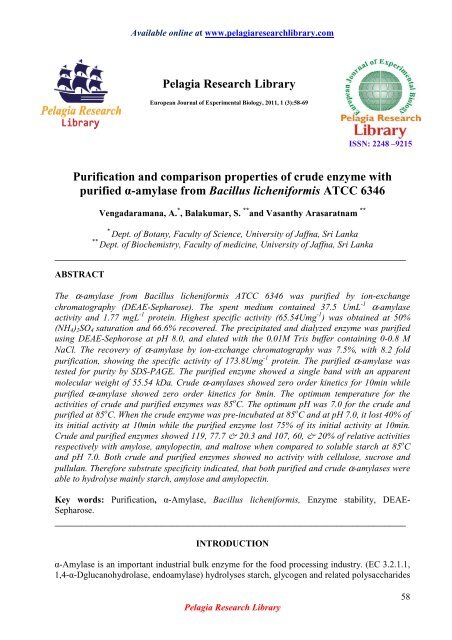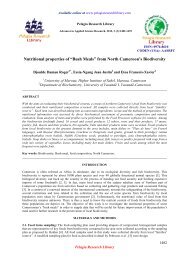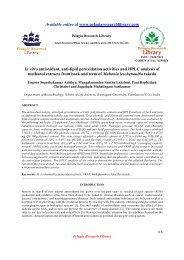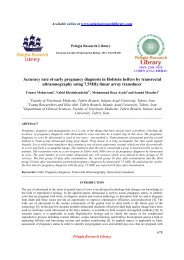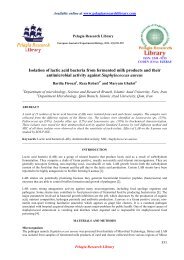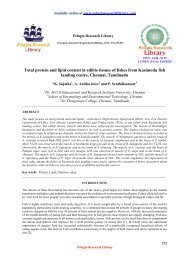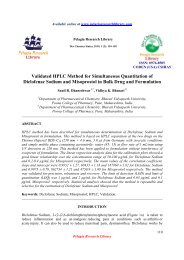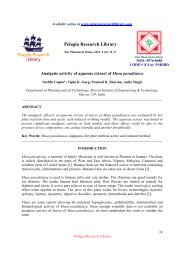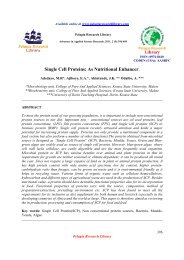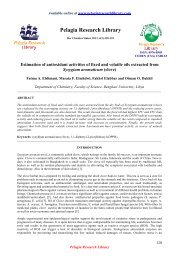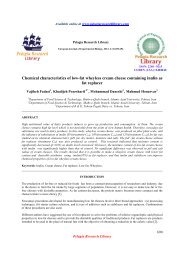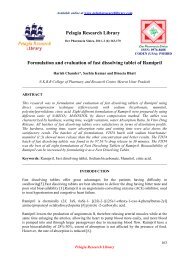Purification and comparison properties of crude enzyme with ...
Purification and comparison properties of crude enzyme with ...
Purification and comparison properties of crude enzyme with ...
You also want an ePaper? Increase the reach of your titles
YUMPU automatically turns print PDFs into web optimized ePapers that Google loves.
Available online at www.pelagiaresearchlibrary.com<br />
Pelagia Research Library<br />
European Journal <strong>of</strong> Experimental Biology, 2011, 1 (3):58-69<br />
ISSN: 2248 –9215<br />
<strong>Purification</strong> <strong>and</strong> <strong>comparison</strong> <strong>properties</strong> <strong>of</strong> <strong>crude</strong> <strong>enzyme</strong> <strong>with</strong><br />
purified α-amylase from Bacillus licheniformis ATCC 6346<br />
Vengadaramana, A. * , Balakumar, S. ** <strong>and</strong> Vasanthy Arasaratnam **<br />
* Dept. <strong>of</strong> Botany, Faculty <strong>of</strong> Science, University <strong>of</strong> Jaffna, Sri Lanka<br />
** Dept. <strong>of</strong> Biochemistry, Faculty <strong>of</strong> medicine, University <strong>of</strong> Jaffna, Sri Lanka<br />
__________________________________________________________________<br />
ABSTRACT<br />
The α-amylase from Bacillus licheniformis ATCC 6346 was purified by ion-exchange<br />
chromatography (DEAE-Sepharose). The spent medium contained 37.5 UmL -1 α-amylase<br />
activity <strong>and</strong> 1.77 mgL -1 protein. Highest specific activity (65.54Umg -1 ) was obtained at 50%<br />
(NH4)2SO4 saturation <strong>and</strong> 66.6% recovered. The precipitated <strong>and</strong> dialyzed <strong>enzyme</strong> was purified<br />
using DEAE-Sephorose at pH 8.0, <strong>and</strong> eluted <strong>with</strong> the 0.01M Tris buffer containing 0-0.8 M<br />
NaCl. The recovery <strong>of</strong> α-amylase by ion-exchange chromatography was 7.5%, <strong>with</strong> 8.2 fold<br />
purification, showing the specific activity <strong>of</strong> 173.8Umg -1 protein. The purified α-amylase was<br />
tested for purity by SDS-PAGE. The purified <strong>enzyme</strong> showed a single b<strong>and</strong> <strong>with</strong> an apparent<br />
molecular weight <strong>of</strong> 55.54 kDa. Crude α-amylases showed zero order kinetics for 10min while<br />
purified α-amylase showed zero order kinetics for 8min. The optimum temperature for the<br />
activities <strong>of</strong> <strong>crude</strong> <strong>and</strong> purified <strong>enzyme</strong>s was 85 o C. The optimum pH was 7.0 for the <strong>crude</strong> <strong>and</strong><br />
purified at 85 o C. When the <strong>crude</strong> <strong>enzyme</strong> was pre-incubated at 85 o C <strong>and</strong> at pH 7.0, it lost 40% <strong>of</strong><br />
its initial activity at 10min while the purified <strong>enzyme</strong> lost 75% <strong>of</strong> its initial activity at 10min.<br />
Crude <strong>and</strong> purified <strong>enzyme</strong>s showed 119, 77.7 & 20.3 <strong>and</strong> 107, 60, & 20% <strong>of</strong> relative activities<br />
respectively <strong>with</strong> amylose, amylopectin, <strong>and</strong> maltose when compared to soluble starch at 85 o C<br />
<strong>and</strong> pH 7.0. Both <strong>crude</strong> <strong>and</strong> purified <strong>enzyme</strong>s showed no activity <strong>with</strong> cellulose, sucrose <strong>and</strong><br />
pullulan. Therefore substrate specificity indicated, that both purified <strong>and</strong> <strong>crude</strong> α-amylases were<br />
able to hydrolyse mainly starch, amylose <strong>and</strong> amylopectin.<br />
Key words: <strong>Purification</strong>, α-Amylase, Bacillus licheniformis, Enzyme stability, DEAE-<br />
Sepharose.<br />
__________________________________________________________________<br />
INTRODUCTION<br />
α-Amylase is an important industrial bulk <strong>enzyme</strong> for the food processing industry. (EC 3.2.1.1,<br />
1,4-α-Dglucanohydrolase, endoamylase) hydrolyses starch, glycogen <strong>and</strong> related polysaccharides<br />
Pelagia Research Library<br />
58
Vengadaramana, A. et al Euro. J. Exp. Bio., 2011, 1(3):58-69<br />
______________________________________________________________________________<br />
by r<strong>and</strong>omly cleaving internal α-1,4-glucosidic linkages to produce different sizes <strong>of</strong><br />
oligosaccharides. It is widely distributed in various bacteria, fungi, plants <strong>and</strong> animals <strong>and</strong> has a<br />
major role in the utilization <strong>of</strong> polysaccharides [1]. α-Amylases are glycoside hydrolases <strong>and</strong><br />
have been classified in family 13 [2]. A number <strong>of</strong> amylases have been reported <strong>with</strong> different<br />
molecular weights, optimum pH <strong>and</strong> temperatures [3].<br />
α-Amylase is an impotent industrial <strong>enzyme</strong> [4]. Among the various extracellular <strong>enzyme</strong>s, αamylase<br />
ranks first in terms <strong>of</strong> commercial uses [5]. Spectrum <strong>of</strong> applications <strong>of</strong> α-amylase has<br />
widened in many sectors such as clinical, medicinal <strong>and</strong> analytical chemistry. Besides their use<br />
in starch saccharification, they also find applications in baking, brewing, detergent, textile, paper<br />
<strong>and</strong> distilling industry [6]. All known α-amylases contain a conserved calcium binding site [7],<br />
[8], [9]. Enzyme production, purification <strong>and</strong> characterization are a growing field <strong>of</strong><br />
biotechnology. The purification <strong>of</strong> α-amylase from the fermented broth is essential for stability<br />
<strong>and</strong> characterization [10]. α-Amylase <strong>with</strong> desirable <strong>properties</strong> such as thermostability, metal ion<br />
dependence, pH spectra <strong>and</strong> others can be very useful in related industries. Our research deal<br />
<strong>with</strong> purification <strong>and</strong> <strong>comparison</strong> kinetic <strong>properties</strong> <strong>of</strong> <strong>crude</strong> <strong>with</strong> purified α-amylase from<br />
Bacillus licheniformis ATCC 6346.<br />
MATERIALS AND METHODS<br />
Strain <strong>of</strong> α-amylase producer <strong>and</strong> <strong>enzyme</strong> production<br />
Bacillus licheniformis ATCC 6346 from Heriot-Watt University U.K was used in this study. The<br />
nutrient agar medium contained (gL -1 ) nutrient agar, 25.0 <strong>and</strong> soluble starch, 3.0 <strong>and</strong> the<br />
activation medium contained (gL -1 ) Nutrient broth, 25.0 <strong>and</strong> soluble starch 3.0 at pH 7.0. The<br />
fermentation medium contained (gL -1 ) soluble starch, 4.0; (NH4)2SO4, 5.0; peptone, 6.0; FeCl3,<br />
0.01; MgCl2.6H2O, 0.01; CaCl2.2H2O, 0.01; KH2PO4, 4.0 <strong>and</strong> K2HPO4, 7.5 at pH 7.0. A loopful<br />
<strong>of</strong> Bacillus licheniformis ATCC 6346 from nutrient agar slants <strong>with</strong> 0.3% soluble starch (grown<br />
at 37 o C for 24h) was transferred to 10mL activation medium which was incubated at 42 o C in a<br />
rotary shaker (100rpm) for 12 hours <strong>and</strong> used as inoculum. The fermentation medium was<br />
inoculated <strong>with</strong> 20% (v/v) inoculum <strong>and</strong> the inoculated flasks were incubated for 48h at 42 o C<br />
<strong>with</strong> shaking at 100rpm. The culture filtrate was used as source <strong>of</strong> α-amylase.<br />
Measurement <strong>of</strong> α-amylase activity<br />
Enzyme was diluted <strong>with</strong> 0.01M phosphate buffer (pH 7.0). The diluted <strong>enzyme</strong> <strong>and</strong> soluble<br />
starch (2gL -1 ) in 0.0lM phosphate buffer (pH 7.0) were pre incubated for 3 min at 85 o C. Then<br />
0.5mL <strong>of</strong> the <strong>enzyme</strong> was mixed <strong>with</strong> 0.5mL substrate <strong>and</strong> incubated for 5min at 85 o C.<br />
Reducing sugar was measured by the DNS method [11]. One unit <strong>of</strong> α-amylase activity is<br />
defined as the amount <strong>of</strong> <strong>enzyme</strong> that produces one μmole <strong>of</strong> reducing sugar in one minute at<br />
85 o C, <strong>and</strong> pH 7.0 from soluble starch (20gL -1 ) as substrate.<br />
<strong>Purification</strong> <strong>of</strong> α-amylase<br />
Effect <strong>of</strong> ammonium sulphate on the precipitation <strong>of</strong> α-amylase<br />
To <strong>crude</strong> α-amylase, solid (NH4)2SO4 was added to bring the (NH4)2SO4 saturation to 10% [12].<br />
The solution was mixed well for 2 hour <strong>and</strong> allowed to settle. Then it was centrifuged (8000rpm<br />
at 4 o C) for 30 minutes. The precipitate was dissolved distilled water <strong>and</strong> dialyzed overnight<br />
against distilled water <strong>and</strong> the α-amylase activity <strong>and</strong> protein content were measured. The<br />
supernatant was dialyzed as said above <strong>and</strong> analyzed for α-amylase activity <strong>and</strong> protein content.<br />
Similar procedure was repeated <strong>with</strong> 20, 30, 40, 50, 60 <strong>and</strong> 70% <strong>of</strong> (NH4)2SO4 saturations. The<br />
α-amylase activities <strong>and</strong> protein contents <strong>of</strong> both supernatants <strong>and</strong> the precipitates were analyzed.<br />
Pelagia Research Library<br />
59
Vengadaramana, A. et al Euro. J. Exp. Bio., 2011, 1(3):58-69<br />
______________________________________________________________________________<br />
Application <strong>of</strong> <strong>enzyme</strong> to activated <strong>and</strong> equilibrated DEAE-Sepharose<br />
To the activated <strong>and</strong> equilibrated (<strong>with</strong> 0.01M Tris buffer, pH 8.0) DEAE-Sepharose TM CL-6B<br />
containing column (Bed volume 5x1cm (3.92ml)), the α-amylase precipitated <strong>with</strong> 50%<br />
ammonium sulphate <strong>and</strong> dialyzed against distilled water (7.0mL) was loaded through the 7mL<br />
loop. To the column first 20ml <strong>of</strong> 0.01M Tris buffer (pH 8.0) was added at a flow rate <strong>of</strong><br />
1mLmin -1 to remove the unbound proteins. After washing the unbound proteins the bound<br />
proteins were eluted <strong>with</strong> a linear gradient (automatic system) <strong>of</strong> 0-0.8 M NaCl in 0.01M Tris<br />
buffer, pH 8.0 (50mL) at a flow rate <strong>of</strong> 1mLmin -1 . Fractions each <strong>of</strong> 1mL volume were collected<br />
using a fraction collector. The samples were analyzed for α-amylase activity <strong>and</strong> protein<br />
contents.<br />
Electrophoresis<br />
The purity <strong>of</strong> the <strong>enzyme</strong> was checked by SDS-PAGE (12.5%) by the Laemmli method [13].<br />
Molecular weight determination<br />
Method <strong>of</strong> Weber <strong>and</strong> Osborn [14] was used.<br />
Effect <strong>of</strong> time<br />
Soluble starch (0.5mL, 20gL -1 in phosphate buffer pH 7.0) was allowed to react <strong>with</strong> <strong>crude</strong> <strong>and</strong><br />
purified α-amylases (0.5mL in 0.01M phosphate buffer pH 7.0) at 85 o C <strong>and</strong> the amount <strong>of</strong><br />
glucose produced was monitored. The time suitable for the incubation was optimized.<br />
Effect <strong>of</strong> temperature<br />
The effect <strong>of</strong> temperature on <strong>crude</strong> <strong>and</strong> purified α-amylase activities were determined by<br />
incubating the appropriately diluted <strong>enzyme</strong> (in 0.01M phosphate buffer, pH 7.0) for optimized<br />
time <strong>with</strong> 0.5mL <strong>of</strong> soluble starch (20gL -1 ) at different temperatures, varied from 40 to 95 o C.<br />
Then activities <strong>of</strong> the <strong>enzyme</strong> samples were measured <strong>and</strong> relative activities were calculated<br />
Effect <strong>of</strong> pH<br />
The effect <strong>of</strong> pH on activities <strong>of</strong> <strong>crude</strong> <strong>and</strong> purified α-amylase were measured by preparing<br />
20gL -1 soluble starch in buffers <strong>of</strong> different pH values ranging from 3.0 to 10.0 (for pH from 3.0<br />
to 6.0 citrate phosphate buffer, for pH 8.0 Tris buffer, for pH 9.0 glycine NaOH buffer <strong>and</strong> for<br />
pH 10.0 carbonate, bicarbonate buffer were used). Enzymes were incubated at optimized<br />
temperatures for optimized period at 85 o C.<br />
Stability <strong>of</strong> <strong>enzyme</strong>s <strong>with</strong> temperature<br />
Crude <strong>and</strong> purified α-amylases were pre-incubated at 85 o C <strong>and</strong> at pH 7.0 <strong>and</strong> the activities <strong>of</strong> the<br />
<strong>enzyme</strong>s were monitored.<br />
Substrate specificity <strong>of</strong> the <strong>enzyme</strong>s<br />
Starch, amylose, amylopectin, pectin, chitin, xylan, cellulose, pullulan, sucrose <strong>and</strong> maltose <strong>of</strong><br />
20gL -1 concentration in 0.01M phosphate buffer (pH 7.0) were prepared <strong>and</strong> were used as<br />
substrates. The activities <strong>of</strong> the <strong>crude</strong> <strong>and</strong> purified <strong>enzyme</strong>s were determined at 85 o C.<br />
RESULTS AND DISCUSSION<br />
To <strong>crude</strong> α-amylase (activity 37.5UmL -1 , protein content 1.77mgmL -1 ) solid (NH4)2SO4 was<br />
added to α-amylase to bring the saturation from 10 to 70% separately. When the saturation<br />
percentage <strong>of</strong> (NH4)2SO4 was increased from 10 to 70%, the precipitation <strong>of</strong> protein was<br />
increased but the <strong>enzyme</strong> activity increased up to 50% <strong>of</strong> (NH4)2SO4. This is because, above 50%<br />
Pelagia Research Library<br />
60
Vengadaramana, A. et al Euro. J. Exp. Bio., 2011, 1(3):58-69<br />
______________________________________________________________________________<br />
<strong>of</strong> (NH4)2SO4 saturation non-<strong>enzyme</strong>-protein could be precipitated. The <strong>crude</strong> <strong>enzyme</strong> sample<br />
precipitated <strong>with</strong> 50% (NH4)2SO4 saturation <strong>and</strong> showed highest specific activity (65 Umg -1<br />
protein) than the samples precipitated <strong>with</strong> different concentration <strong>of</strong> (NH4)2SO4 (Table I). By<br />
these (NH4)2SO4 precipitation, the specific activity <strong>of</strong> α-amylase has increased by 3 times than<br />
that <strong>of</strong> <strong>crude</strong> <strong>enzyme</strong> 66.6% yield. In supernatant, when the saturation percentage <strong>of</strong> (NH4)2SO4<br />
was increased from 10 to 70%, the protein content <strong>and</strong> <strong>enzyme</strong> activity were reduced. α-Amylase<br />
from Bacillus sp.WN11, purified <strong>with</strong> 60% (NH4)2SO4 saturation showed the specific activity <strong>of</strong><br />
205 Umg -1 , which was 9.0 fold higher than that <strong>of</strong> the <strong>crude</strong> <strong>enzyme</strong> <strong>with</strong> 67% yield [15]. α-<br />
Amylase from Bacillus licheniformis CUMC 305 precipitated <strong>with</strong> 30-60% ammonium sulphate,<br />
showed 28 Umg -1 specific activity, <strong>with</strong> 6.7 fold purification <strong>and</strong> 51.6% yield [16]. When α-<br />
Amylase from Bacillus subtilis AX20 was saturated <strong>with</strong> 70% (NH4)2SO4, 119.8 Umg -1 specific<br />
activity was obtained, which was 1.1 fold higher than the <strong>crude</strong> <strong>enzyme</strong> in the 94.2% yield [17].<br />
Ammonium sulphte (50%) precipitation increased the specific activity <strong>of</strong> α-amylase from B.<br />
licheniformis ATCC 6346 by 3 times than that <strong>of</strong> the <strong>crude</strong> <strong>enzyme</strong>.<br />
Table I : Effect <strong>of</strong> ammonium sulphate saturation (in percentage) on the precipitation <strong>of</strong> α-amylase from spent medium<br />
(NH4)2SO4<br />
(%)<br />
α-Amylase<br />
activity<br />
(UmL -1 )<br />
Precipitate Supernatant<br />
Protein<br />
(mgmL -1 )<br />
Specific<br />
activity<br />
(UmL -1 )<br />
Activity<br />
(%)<br />
α-Amylase<br />
activity<br />
(UmL -1 )<br />
Pelagia Research Library<br />
Protein<br />
(mgmL -1 )<br />
Specific<br />
activity<br />
(UmL -1 )<br />
Activity<br />
(%)<br />
10 17.03 0.563 30.2 14.98 8.8 0.758 11.6 11.73<br />
20 29.74 0.741 40.1 27.75 7.2 0.642 11.2 10.75<br />
30 33.56 0.696 48.2 33.11 6.3 0.626 10.0 10.08<br />
40 40.56 0.712 56.9 43.26 5.7 0.585 9.7 10.03<br />
50 58.86 0.905 65.0 67.49 4.5 0.552 8.1 8.52<br />
60 57.14 1.397 40.9 76.18 3.3 0.462 7.1 7.04<br />
70 56.01 2.154 26.0 77.66 0.0 0.316 0.0 0.00<br />
To the activated <strong>and</strong> equilibrated DEAE-Sepharose containing column [column size 11.5x1cm<br />
<strong>and</strong> bed volume 5x1cm (3.92mL)] the (NH4)2SO4 precipitated sample was loaded through 7mL<br />
loop. The (NH4)2SO4 precipitated sample contained a total protein <strong>of</strong> 57.21mg <strong>and</strong> the total αamylase<br />
activity <strong>of</strong> 3750Units. When the gel was washed first <strong>with</strong> 0.01M Tris buffer (pH 8.0,<br />
20mL) at a flow rate <strong>of</strong> 1mLmin -1 , the unbound proteins in the (NH4)2SO4 precipitated <strong>and</strong><br />
dialyzed sample was washed away. The bound α-amylase was eluted at a flow rate <strong>of</strong> 1mLmin -1<br />
by using linear gradient <strong>of</strong> 0-0.8M NaCl in 0.01M Tris buffer.<br />
The fractions from 6 to 29 eluted <strong>with</strong> NaCl buffer (0.01M Tris buffer, pH 8.0) solution<br />
contained proteins <strong>with</strong>out α-amylase activity. The protein content was increased again in the<br />
fractions from 36 to 47. The fractions from 37 to 47 (11fractions) contained α-amylase activity.<br />
Among the fractions, fraction 41 had the highest <strong>enzyme</strong> activity (Fig. 1). The fractions from 37<br />
to 47 were pooled <strong>and</strong> this pooled <strong>enzyme</strong> (11fractions) showed 38.33 UmL -1 <strong>enzyme</strong> activitiy,<br />
containing 0.2205 mgml -1 protein. Other fractions from 47 to 77 contained non <strong>enzyme</strong> protein.<br />
By this ion exchange purification, the specific activity <strong>of</strong> α-amylase was increased from 65.54<br />
to173.8 Umg -1 protein (Table II), which was 8.2 fold higher than that <strong>of</strong> the <strong>crude</strong> α-amylase<br />
<strong>with</strong> 7.5% yield.<br />
61
Vengadaramana, A. et al Euro. J. Exp. Bio., 2011, 1(3):58-69<br />
______________________________________________________________________________<br />
Figure 1: Speration <strong>of</strong> α-amylase from 50% ammonium sulphate precipitated <strong>and</strong> dialyzed sample by Ion-exchange<br />
chromatography on DEAE-Sepharose fast flow column. (▲) α-amylase activity (UmL -1 ) <strong>and</strong> (●) Proteins (absorbance at<br />
280nm) eluted <strong>with</strong> 0-0.8M NaCl containing 0.01M Tris buffer (pH 8.0) at flow rate <strong>of</strong> 1mlmin -1<br />
Table II: <strong>Purification</strong> <strong>of</strong> <strong>crude</strong> α-amylase by precipitation <strong>with</strong> 50% ammonium sulphate <strong>and</strong> ion exchange<br />
chromatography using DEAE-Sepharose<br />
<strong>Purification</strong><br />
step<br />
Volume<br />
Total<br />
activity (U)<br />
Total protein<br />
(mg)<br />
Specific activity<br />
(Umg -1 )<br />
<strong>Purification</strong><br />
fold<br />
Recover<br />
(%)<br />
Crude 150 5625 265.5 21.18 1 100<br />
(NH4)2SO4<br />
(50%)<br />
DEAE-<br />
Sepharose<br />
7 3750 57.21 65.54 3 66.6<br />
11 421.63 2.425 173.8 8.2 7.5<br />
While purifying the α-amylase from Bacillus sp. WN11 by using DEAE-Sepharose, 2.7mg <strong>of</strong><br />
total protein was obtained where the protein content <strong>of</strong> the initial sample was 6.7mg <strong>and</strong> the total<br />
activity recovered was 1015.0U while the initial activity was 1374.0U <strong>with</strong> the specific activity<br />
<strong>of</strong> 375.9.2Umg -1 , which was 16.5 fold higher than the initial sample <strong>and</strong> have obtained 49.5% <strong>of</strong><br />
yield [15]. When α-amylase from Bacillus subtilis was purified using DEAE-Sephadex A-50,<br />
total protein recovered was 33.6mg <strong>with</strong> a total activity <strong>of</strong> 24024 U <strong>and</strong> the specific activity <strong>of</strong><br />
715Umg -1 which was 7.8 fold higher than that initial sample <strong>with</strong> 26.6% yield [18]. When the<br />
pooled sample <strong>of</strong> purified α-amylase was subjected to gel electrophoretic separation, <strong>and</strong> stained<br />
<strong>with</strong> coomassie brilliant blue the sample gave single b<strong>and</strong> (Fig. 2). This single b<strong>and</strong> indicated<br />
that one type <strong>of</strong> α-amylase was produced by this bacteria <strong>and</strong> further purification steps are not<br />
needed.<br />
Pelagia Research Library<br />
62
Vengadaramana, A. et al Euro. J. Exp. Bio., 2011, 1(3):58-69<br />
______________________________________________________________________________<br />
Figure 2: SDS-PAGE pattern <strong>of</strong> purified α-amylase from Bacillus licheniformis ATCC 6346. St<strong>and</strong>ard<br />
proteins from Fermentas, certificate <strong>of</strong> analysis: protein Ladder. Lane A: marker proteins; Lane B: purified<br />
α-amylase sample.<br />
The apparent molecular weight <strong>of</strong> the purified α-amylase was estimated by the method <strong>of</strong> Weber<br />
<strong>and</strong> Osborn [14]. The distance traveled by molecular markers <strong>and</strong> purified α-amylase were<br />
measured. The linear relationship existed between the logarithm <strong>of</strong> molecular weight <strong>of</strong><br />
molecular markers <strong>and</strong> distance migrated by molecular markers (Table III). From this method the<br />
molecular weight <strong>of</strong> the purified α-amylase estimated to be 55540Da (Fig. 3). The molecular<br />
weight <strong>of</strong> this α-amylase (55540Da) closely resembled the molecular weight (56000 Da) <strong>of</strong> the<br />
α-amylase from Bacillus subtilis determined by SDS-PAGE <strong>and</strong> the value determined by gel<br />
permeation chromatography is 54000 Da [18] <strong>and</strong> higher than that reported for B.licheniformis<br />
584 α-amylase (22500 Da; [19]).<br />
Table III: The distance migrated by the molecular markers <strong>and</strong> purified α-amylase from starting point. The<br />
distances were measured from SDS-PAGE gel stained <strong>with</strong> coomassie brilliant blue<br />
Molecular weight Molecular weight<br />
Distance migrated from starting point (cm)<br />
(kDa)<br />
(Log)<br />
30 1.47 2.70<br />
40 1.60 2.00<br />
50 1.69 1.60<br />
60 1.77 1.35<br />
70 1.84 1.20<br />
85 1.92 1.00<br />
100 2.0 0.85<br />
120 2.07 0.70<br />
150 2.17 0.60<br />
200 2.3 0.50<br />
Purified α-amylase 1.45<br />
Pelagia Research Library<br />
63
Vengadaramana, A. et al Euro. J. Exp. Bio., 2011, 1(3):58-69<br />
______________________________________________________________________________<br />
Determining the optimum time for α-amylase activity measurement<br />
Crude α-amylase preparation showed a linear relationship between the time <strong>and</strong> production up to<br />
10minutes but purified <strong>enzyme</strong> showed up to 8 minutes (Fig. 4). Hence, it was decided to fix the<br />
reaction time for 5min.<br />
Figure 3: Determination <strong>of</strong> molecular weight <strong>of</strong> purified α-amylase by SDS-PAGE <strong>and</strong> purified by DEAE-<br />
Sepharose. The molecular markers used were from Fermentas, certificate <strong>of</strong> analysis: protein Ladder co Ltd,<br />
1:-50; 2:-60; 3:-70; 4:-85; 5:-100 <strong>and</strong> 6:-120kDa.<br />
Effect <strong>of</strong> temperature on the activity <strong>of</strong> <strong>crude</strong> <strong>and</strong> purified α-amylase<br />
The initial relative activity <strong>of</strong> <strong>crude</strong> <strong>and</strong> purified α-amylase increased to 100% as the<br />
temperature increased up to 85 o C (Fig. 5). Maximum activity was obtained at 85 o C <strong>and</strong> pH 7.0<br />
for the substrate starch (20gL -1 ). Above 85 o C, α-amylase activity was decreased sharply due to<br />
thermal denaturation <strong>of</strong> the <strong>enzyme</strong> <strong>and</strong> lost the activity. Hence 85 o C was chosen as the optimum<br />
temperature for the assay <strong>of</strong> <strong>crude</strong> <strong>and</strong> purified α-amylases.<br />
Bacillus licheniformis ATCC 6346 producing <strong>crude</strong> <strong>and</strong> purified α-amylases showed highest<br />
activity at 85 o C. The proteins, other than <strong>enzyme</strong> proteins present in the <strong>crude</strong> <strong>enzyme</strong> has not<br />
influenced the activity <strong>of</strong> <strong>enzyme</strong> at different temperatures. The purified α-amylase <strong>of</strong> Bacillus<br />
licheniformis CUMC 305 showed maximal activity at 90 o C <strong>and</strong> pH 9.0 [16]. The purified αamylase<br />
obtained from Bacillus subtilis was optimally active at 80 o C <strong>and</strong> pH 5.6 [18]. Maximum<br />
activity <strong>of</strong> α-amylase from Bacillus licheniformis BLM 1777 was obtained at 85 o C <strong>and</strong> at pH 6.0<br />
[20].<br />
Pelagia Research Library<br />
64
Vengadaramana, A. et al Euro. J. Exp. Bio., 2011, 1(3):58-69<br />
______________________________________________________________________________<br />
Effect <strong>of</strong> pH on the activity <strong>of</strong> <strong>crude</strong> <strong>and</strong> purified α-amylases<br />
When the pH was increased, the maximum activities <strong>of</strong> <strong>crude</strong> <strong>and</strong> purified α-amylases were<br />
obtained at pH 7.0 (Fig. 6). Increase in the activities were observed <strong>of</strong> <strong>crude</strong> <strong>enzyme</strong> at pH 9.0<br />
but the activities were less than that obtained at pH 7.0. Neutral pH was found to be optimal for<br />
amylase production by B.thermooleovorans NP54 as also reported in B.coagulans [21],<br />
B.licheniformis [16] <strong>and</strong> B. Brevis [22]. The dependence <strong>of</strong> <strong>enzyme</strong> activity on pH is a<br />
consequence <strong>of</strong> the amphoteric <strong>properties</strong> <strong>of</strong> proteins [23]. The majority <strong>of</strong> thermostable αamylases<br />
from Bacillus spp, heret<strong>of</strong>ore purified, have shown maximal activity in the acidic to<br />
neutral pH range [16]. The optimum pH <strong>of</strong> activity <strong>of</strong> purified α-amylase from Bacillus sp. TS-<br />
23 <strong>and</strong> Thermus sp were 9.0 <strong>and</strong> 5.5-6.5 respectively [24].<br />
Glucose produced (µmolmL -1 )<br />
500<br />
400<br />
300<br />
200<br />
100<br />
0<br />
0 10 20 30 40 50 60<br />
Time (min)<br />
Figure 4: Production <strong>of</strong> glucose (●), <strong>crude</strong> <strong>and</strong> (▲), purified α-amylase preparation on starch (20gL -1 )-0.01M<br />
phosphate buffer (pH 7.0) at 85 o C.<br />
Stability <strong>of</strong> <strong>crude</strong> <strong>and</strong> purified α-amylases at 85 o C<br />
When the <strong>crude</strong> α-amylase was pre-incubated at 85 o C <strong>and</strong> pH 7.0 for 30min it retained 31.2% <strong>of</strong><br />
its initial activity <strong>and</strong> when it was pre-incubated at 85 o C for 60min, lost all its activity (Fig. 7).<br />
The purified α-amylase retained 10.69 <strong>and</strong> 9.57% <strong>of</strong> its initial activity at 30 <strong>and</strong> 60min<br />
respectively at 85 o C <strong>and</strong> pH 7.0 (0.01M Tris buffer). Half-life <strong>of</strong> <strong>crude</strong> <strong>and</strong> purified α-amylases<br />
were 13.9 <strong>and</strong> 4.7min respectively. Therefore in this case purification has reduced the α-amylase<br />
stability at 85 o C. Presence <strong>of</strong> some proteins other than <strong>enzyme</strong> protein could support the stability<br />
<strong>of</strong> <strong>crude</strong> α-amylase. The extra thermostability <strong>of</strong> the thermophilic α-amylase was found to be<br />
mainly due to additional salt bridges involving a few specific lysine residues (Lys-385 <strong>and</strong> Lys-<br />
88 <strong>and</strong>/or Lys-253). These stabilizing electrostatic interactions reduce the extent <strong>of</strong> unfolding <strong>of</strong><br />
the <strong>enzyme</strong> molecule at high temperatures, consequently making it less prone to forming<br />
incorrect (scrambled) structures <strong>and</strong> thus decreasing the overall rate <strong>of</strong> irreversible<br />
thermoinactivation [25]. α-Amylase from Bacillus sp. WN11 retained 50% <strong>of</strong> its initial activity<br />
Pelagia Research Library<br />
65
Vengadaramana, A. et al Euro. J. Exp. Bio., 2011, 1(3):58-69<br />
______________________________________________________________________________<br />
at 4h when the <strong>enzyme</strong> was incubated at 80 o C [15]. Half-life <strong>of</strong> Bacillus thermooleovorans NP54<br />
producing α-amylase was 3h at 100 o C <strong>and</strong> pH 8.0 [26].<br />
Relative activity (%)<br />
100<br />
80<br />
60<br />
40<br />
20<br />
0<br />
35 45 55 65 75 85 95<br />
Temperature o C<br />
Figure 5: Effect <strong>of</strong> temperature on the activity <strong>of</strong> (●), <strong>crude</strong> <strong>and</strong> (▲), purified α-amylases <strong>with</strong> starch (20gL -1 )<br />
at pH 7.0. α-Amylases activity were measured at different temperatures <strong>of</strong> 40, 50, 60, 70, 75, 80, 85, 90 <strong>and</strong><br />
95 o C, using 20gL -1 starch as substrate by incubating for 5minutes at pH 7.0 (0.01M phosphate buffer).<br />
Comparison <strong>of</strong> substrate specificity <strong>of</strong> the <strong>crude</strong> <strong>and</strong> purified α-amylases<br />
Different substrates were hydrolyzed by <strong>crude</strong> <strong>and</strong> purified α-amylases. When 20gL -1 <strong>of</strong><br />
amylose, amylopectin, pectin, chitin, xylan <strong>and</strong> maltose were used as substrates to <strong>crude</strong> <strong>enzyme</strong><br />
that showed 119.3, 77.7, 25.5, 27.4, 5.7 <strong>and</strong> 20.3% <strong>of</strong> relative activity (Table IV) when<br />
compared to soluble starch <strong>and</strong> no activity was observed when cellulose, pullulan <strong>and</strong> sucrose<br />
were used as substrates at 85 o C <strong>and</strong> pH 7.0 (0.01M phosphate buffer). When 20gL -1 <strong>of</strong> amylose,<br />
amylopectin, pectin, chitin, xylan <strong>and</strong> maltose were used as substrate to purified <strong>enzyme</strong>, it<br />
showed 107.42, 60.02, 19.64, 21.17, 0, <strong>and</strong> 20.3% <strong>of</strong> relative activity (Table IV) when compared<br />
to soluble starch at 85 o C <strong>and</strong> pH 7.0. α-Amylase does not hydrolyse cellulose because it dose not<br />
hydrolyse ß(1→4) linkages. But from chitin reducing sugars were obtained at slower rate at<br />
85 o C.<br />
Pelagia Research Library<br />
66
Vengadaramana, A. et al Euro. J. Exp. Bio., 2011, 1(3):58-69<br />
______________________________________________________________________________<br />
Relative activity (%)<br />
100<br />
80<br />
60<br />
40<br />
20<br />
0<br />
3 4 5 6 7 8 9 10<br />
pH<br />
Figure 6: Effect <strong>of</strong> pH on the activity <strong>of</strong> (●), <strong>crude</strong> <strong>and</strong> (▲), purified α-amylases <strong>with</strong> starch (20gL -1 ) at pH 85 o C.<br />
Activities were measured at different pH, using 20gL -1 starch as substrate by incubating for 5minutes at 85 o C.<br />
Chitin contains ß(1→4) linkage here the products should have been obtained by the <strong>enzyme</strong><br />
activity. The results indicated that the substrate samples contained some impurities. Both <strong>crude</strong><br />
<strong>and</strong> purified <strong>enzyme</strong>s hydrolysed maltose at slower rate. Study <strong>of</strong> the substrate specificity<br />
indicated that the <strong>enzyme</strong> was able to hydrolyse mainly starch, amylopection <strong>and</strong> amylose.<br />
Maltose was slowely hydrolyzed at 85 o C <strong>and</strong> at pH 7.0.<br />
The relative rates <strong>of</strong> hydrolysis <strong>of</strong> amylase, soluble starch, amylopectin <strong>and</strong> dextrin by αamylase<br />
from Bacteroides amlophilus were 100, 97, 92 <strong>and</strong> 60% respectively [27]. Krishnan et<br />
al [16] showed that the substrate specificity <strong>of</strong> purified α-amylase from Bacillus licheniformis<br />
CUMC305 <strong>with</strong> different 1% substrates, release <strong>of</strong> reducing sugar were very rapid from amylase<br />
(129%) but was slower from soluble starch (101.4%), amylopectin (58.3%) <strong>and</strong> glycogen<br />
(100%). α-Amylase from Streptococcus bovis JB1, exhibited neither pullulanase nor dextranase<br />
activity <strong>and</strong> hydrolysis <strong>of</strong> amylase, starch <strong>and</strong> amylopectin were 100, 100 <strong>and</strong> 70% respectively<br />
[28]. Starch, amylase <strong>and</strong> amylopctin were the substrates preferentially hydrolysed by α-amylase<br />
from Aspergillus tamari [29].<br />
Pelagia Research Library<br />
67
Vengadaramana, A. et al Euro. J. Exp. Bio., 2011, 1(3):58-69<br />
______________________________________________________________________________<br />
Relative activity (%)<br />
100<br />
80<br />
60<br />
40<br />
20<br />
0<br />
0 10 20 30 40 50 60<br />
Time (min)<br />
Figure 7: Stability <strong>of</strong> (●), <strong>crude</strong> <strong>and</strong> (▲), purified α-amylases. α-Amylase activity was measured at 85 o C using<br />
20gL -1 starch as substrate by incubating for 5minutes at pH 7.0 (0.01M phosphate buffer).<br />
Table IV: Effect <strong>of</strong> different carbon sources on the activity <strong>of</strong> <strong>crude</strong> <strong>and</strong> purified α-amylase produced by<br />
B.licheniformis. α-Amylase activity was determined at 85 o C <strong>and</strong> pH 7.0 (0.01M phosphate buffer) using 20gL -<br />
1 different substrate by incubating for at 5minutes.<br />
Substrate<br />
(20gL -1 Relative α-amylase activity (%)<br />
) Crude Purified<br />
Starch (control) 100 100<br />
Amylose 119.3 107.42<br />
Amylopectin 77.7 60.02<br />
Pectin 25.5 19.64<br />
Chitin 27.4 21.70<br />
Xylan 5.7 0.00<br />
Cellulose 0.0 0.00<br />
Pullulan 0.0 0.00<br />
Sucrose 0.0 0.00<br />
Maltose 20.3 20.06<br />
CONCLUSION<br />
The specific activity <strong>of</strong> the <strong>crude</strong> <strong>enzyme</strong> was 21.18 Umg -1 protein <strong>and</strong> this was increased to<br />
65.54 Umg -1 protein by (NH4)2SO4 precipitation. Further purification by ion exchange<br />
chromatography had increased the specific activity to 173.8 Umg -1 protein. A thermostable αamylase<br />
55.540 kDa (MW) produced by mesophilic Bacillus licheniformis ATCC 6346, has been<br />
Pelagia Research Library<br />
68
Vengadaramana, A. et al Euro. J. Exp. Bio., 2011, 1(3):58-69<br />
______________________________________________________________________________<br />
purified to homogeneity. The optimum pH <strong>of</strong> <strong>crude</strong> <strong>and</strong> purified α-amylase from Bacillus<br />
licheniformis ATCC 6346 α-amylase was pH 7.0. The <strong>enzyme</strong> was more specific to hydrolyse<br />
α(1→4) linkages between glucose units. Future work includes effect <strong>of</strong> metal ions on the<br />
stability <strong>of</strong> purified α-amylase.<br />
Acknowledgment<br />
The authors thank Sida/SAREC <strong>and</strong> International Science Programme <strong>of</strong> Chemical Sciences<br />
(IPICS), Sweden for the financial support.<br />
REFERENCES<br />
[1] MF. Najafi, D. Deobagkar, Electronic J. <strong>of</strong> Biotechnol., 2005, 8(2), 197-203.<br />
[2] B. Henrissat, A. Bairoch, J. <strong>of</strong> Biochem., 1996, 316, 695-696<br />
[3] A. P<strong>and</strong>y, P. Nigam, CR. Soccol, VT. Soccol, D. Singh, R. Mohan, Biotechnol. Appl.<br />
Biochem., 2000, 31, 135-152.<br />
[4] JF. Shaw, FP. Lin, SC. Chen, HC. Chen, Bot. Bull. Acad. Sin., 1995, 36, 195–200.<br />
[5] KR. Babu, T. Satyanarayana, Folia Microbiol, 1993, 38, 77–80.<br />
[6] S. Ramach<strong>and</strong>ran, AK. Patel, KM. Nampoothiri, S. Ch<strong>and</strong>ran, G. Szakacs, CR. Soccol, A.<br />
P<strong>and</strong>ey, Brazilian Archives <strong>of</strong> Biology <strong>and</strong> Technology, 2004, 47, 309–317.<br />
[7] E. Boel, L. Brady, AM. Brzozowski, Z. Derewenda, GG. Dodson, VJ. Jensen, SB. Petersen,<br />
H. Swift, L. Thim, HF. Woldike, Biochem., 1990, 29, 6244-6249.<br />
[8] M. Machius, N. Declerck, R. Huber, G. Wieg<strong>and</strong>, Structure, 1998, 6, 281-292.<br />
[9] M. Machius, G. Wieg<strong>and</strong>, R. Hubber, J.Mol. Biol., 1995, 246, 545-559.<br />
[10] Ikram-Ul-Haq, MM. Javed, U. Hameed, F. An<strong>and</strong>, Pak. J. <strong>of</strong> Bot, 2010, 42(5), 3507-3516<br />
[11] G. Miller, Anal. Chem., 1959, 31, 426-428.<br />
[12] RMC. Dawson, DC. Elliott, WH. Elliot, KM. Jones, Data for biochemical research 2 nd<br />
edition Oxford Univ.Press, London, 1969.<br />
[13] UK. Laemmli, Nature, 1970, 227, 680-685.<br />
[14] K. Weber, Osborn, J. <strong>of</strong> Biol. Chem., 1969, 244, 4406-4412<br />
[15] G. Mamo, BA. Gashe, Gessese, J. <strong>of</strong> .Applied. Microbiology, 1999, 86(4), 557-560.<br />
[16] T. Krishnan, AK. Ch<strong>and</strong>ra, Appl. Enviorn. Microbiol., 1983, 46, 430-437<br />
[17] FJ. Mohsen, D. Dileep, D. Deepti, Protein Expression <strong>and</strong> <strong>Purification</strong>, 2005, 41, 349-354.<br />
[18] GC. Ugru, DA. Robb, JA. Akinyanju, A. Sani, J. <strong>of</strong> Industrial. Microbiol. & Biotechnol.,<br />
1997, 19, 273-279<br />
[19] N. Salto, Arch. Biochem. Biophys., 1973, 155, 290-298.<br />
[20] JP. Chiang, JE. Alter, M. Sternberg-Elkhart, Starch/Strake, 1979, 31, 86-92<br />
[21] S. Medda, AK. Ch<strong>and</strong>ra, J. <strong>of</strong> Gen. Appl. Bacteriol., 1980, 48, 47-58.<br />
[22] VT. Tsvetkov, EI. Emanyilova, J. <strong>of</strong> Appl. Microbiol. <strong>and</strong> Biotechnol., 1989, 31: 246-248<br />
[23] BL. Williams, K. Wilson, A biologist guide to principles <strong>and</strong> techniques <strong>of</strong> practical<br />
Biochemistry Arnold (Publishers).Ltd, London, 1983.<br />
[24] Jey-Fu Shaw, Fu-Pang Lin, Su-Chiu Chen, Hsing-Chen Chen, Bot. Bull. Acad. Sin., 1995,<br />
36, 195-200.<br />
[25] SJ. Tomazic, AM. Klibanov, J. <strong>of</strong> Biol.Chem., 1988, 263, 3092-3096.<br />
[26] R. Malhotra, SM. Noorwez, T. Sathyanarayanan, Lett. Appl. Microbiol., 2000, 31, 378-384<br />
[27] J. Steven, MC. Wethy, A. Haetman, J. <strong>of</strong> Bacteriol., 1976, 129(2), 1537-1544<br />
[28] N. Shelyby, Appli <strong>and</strong> Enviorn. Microbiol., 1993, 59, 1398-1402.<br />
[29] GM. Fabiana, L. Veridiana, MP. Rosane, J. <strong>of</strong> Basic Microbiol., 2004, 44, 1, 29-25.<br />
Pelagia Research Library<br />
69


